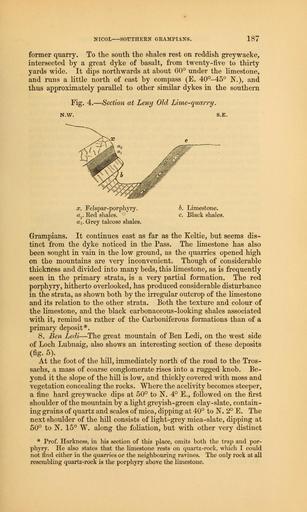MAKE A MEME
View Large Image

| View Original: | The_Quarterly_journal_of_the_Geological_Society_of_London_(12645850893).jpg (1225x2046) | |||
| Download: | Original | Medium | Small | Thumb |
| Courtesy of: | commons.wikimedia.org | More Like This | ||
| Keywords: The Quarterly journal of the Geological Society of London (12645850893).jpg NICOL SOUTHERN GRAMPIANS <br> 187 <br> former quarry To the south the shales rest on reddish greywacke <br> intersected by a great dyke of basalt from twenty-five to thirty <br> yards wide It dips northwards at about 60┬░ under the limestone <br> and runs a little north of east by compass E 40┬░-45┬░ N and <br> thus approximately parallel to other similar dykes in the southern <br> Fig 4 ö Section at Leny Old Lime-quarry <br> N W <br> S E <br> A <br> A <br> x Felspar-porphyry <br> a 2 Ked shales <br> a x Grey talcose shales <br> b Limestone <br> c Black shales <br> Grampians It continues east as far as the Keltie but seems dis- <br> tinct from the dyke noticed in the Pass The limestone has also <br> been sought in vain in the low ground as the quarries opened high <br> on the mountains are very inconvenient Though of considerable <br> thickness and divided into many beds this limestone as is frequently <br> seen in the primary strata is a very partial formation The red <br> porphyry hitherto overlooked has produced considerable disturbance <br> in the strata as shown both by the irregular outcrop of the limestone <br> and its relation to the other strata Both the texture and colour of <br> the limestone and the black carbonaceous-looking shales associated <br> with it remind us rather of the Carboniferous formations than of a <br> primary deposit <br> 8 Ben Ledi ö The great mountain of Ben Ledi on the west side <br> of Loch Lubnaig also shows an interesting section of these deposits <br> fig 5 <br> At the foot of the hill immediately north of the road to the Tros- <br> sachs a mass of coarse conglomerate rises into a rugged knob Be- <br> yond it the slope of the hill is low and thickly covered with moss and <br> vegetation concealing the rocks Where the acclivity becomes steeper <br> a fine hard greywacke dips at 50┬░ to N 4┬░ E followed on the first <br> shoulder of the mountain by a light greyish-green clay-slate contain- <br> ing grains of quartz and scales of mica dipping at 40┬░ to N 2┬░ E The <br> next shoulder of the hill consists of light-grey mica-slate dipping at <br> 50┬░ to N 15┬░ W along the foliation but with other very distinct <br> Prof Harkness in his section of this place omits both the trap and por- <br> phyry He also states that the limestone rests on quartz -rock which I could <br> not find either in the quarries or the neighbouring ravines The only rock at all <br> resembling quartz-rock is the porphyry above the limestone 35328148 109632 51125 Page 187 Text v 19 http //www biodiversitylibrary org/page/35328148 1863 Geological Society of London NameFound Tros NameConfirmed Tros NameBankID 3003360 Biodiversity Heritage Library The Quarterly journal of the Geological Society of London v 19 1863 Geology Periodicals Smithsonian Libraries bhl page 35328148 dc identifier http //biodiversitylibrary org/page/35328148 smithsonian libraries Information field Flickr posted date ISOdate 2014-02-20 Check categories 2015 August 26 CC-BY-2 0 BioDivLibrary https //flickr com/photos/61021753 N02/12645850893 2015-08-27 11 52 31 cc-by-2 0 PD-old-70-1923 The Quarterly journal of the Geological Society of London 1863 Photos uploaded from Flickr by F├” using a script | ||||